Why were animals useful in World War One?
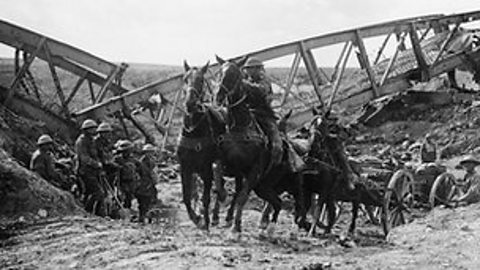
Before 1914 wars had mainly been fought by cavalries (soldiers who fought on horseback).
But both sides in World War One soon realised the muddy ground, barbed wire and machine guns made it too difficult to use horses for fighting.
Instead millions of horses were used to carry people and supplies.
Many other animals played a big part in the war as workers and mascots.

Watch: How animals helped soldiers
Watch our video to find out more about animals in war.
[SNARE DRUM]
DOG: Did members of your family fight or help in World War One?
Well guess what? Mine did.
WARTIME DOG: [PANTING] Sorry, I canât stop now! Iâm on an urgent mission.
And itâs not just me. There are thousands of dogs here on the battlefront.
Take my pal Bully. Heâs a mascot for a Batallion. It really cheers them up âaving him around.
LIGHTENING: [PANTING] Coming through, make way!
WARTIME DOG: Thatâs Lightening.
She carries urgent messages. Fast as a bullet.
Sheâs great at running across these difficult battlefields and sheâs very brave.
SNIFFER DOG: Psst! Yesterday I got a whiff of a spy over a thousand metres away.
WARTIME DOG: Itâs true! Some of us can sniff out the enemy.
Others are trained to keep watch for them and weâre not the only animals out here.
HORSE: These battlefields are too tough for vehicles but horses are strong and we can get through the mud.
Before the war I worked on a farm.
HORSE 2: I was a family pet. We needed to walk for days and days carrying equipment, carrying food, carrying wounded men. But we keep going!
WARTIME DOG: By the end of the war millions of them will have died but they keep going.
PIGEON: So do we! Do you wanna get an urgent message from the front line to HQ?
Then use a pigeon!
Weâre fast, hard to shoot down and we can always find our way home.
Thatâs why there are 100,000 of us out here.
WARTIME DOG: Even the smallest animals can help out.
These glow worms give off a natural light so they are very useful for soldiers in the dark trenches.
In my job to find and help wounded and dying soldiers I carry medical supplies with me.
DOG: Iâm proud of the job my family did on the battlefield.
And maybe, when you next see a pigeon fly past or a horse galloping in a field or when you throw me one of those great crunchy sticks, youâll remember all the animals that helped in the war.
CHILD: Good boy!
How were animals used for work?
Many types and breeds of animals were well-suited to perform tasks such as guarding trenches, finding wounded soldiers and carrying messages.
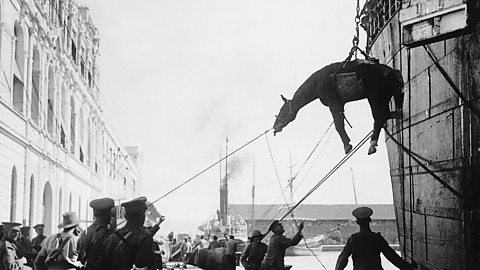
Image caption, Horses carried wounded soldiers or weaponry
They had to be strong as fully armed and equipped soldiers were heavy. In total, around 8 million horses from all sides died during the war.
Image caption, Sentry dogs stayed with one soldier and guarded trenches
They were taught to give a warning sound such as growling or barking when they sensed a stranger close to camp. Many Dobermans were used as sentry dogs.
Image caption, Scout dogs were used to find the enemy
They could detect smells up to 1000 yards away. They were trained not to bark as this would draw attention. Instead they would give a silent signal, like raising their tail.
Image caption, Casualty dogs were trained to find wounded or dying soldiers
They carried medical equipment so an injured soldier could treat himself. They would also stay beside a dying soldier to keep him company.
Image caption, Carrier pigeons were used as messengers during the war
Pigeons always flew home when released, so troops made sure the pigeons' nests were in places where they needed to send messages.
Image caption, Some pigeons were kept in unusual places like old London buses
Homing pigeons became so valuable to the British army, the punishment for killing or wounding one was six months imprisonment or ÂŁ100 fine.
Image caption, Elephants helped to pull artillery
Photos of elephants working were used to show people back home that even exotic animals were 'doing their bit' in the war effort.
1 of 7
Pets, mascots and livestock
There are many stories of animals who became companions to soldiers.
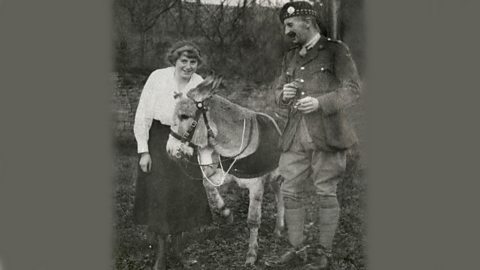
Image caption, Jimmy 'The Sergeant' was a donkey born at the Battle of the Somme
Jimmy was wounded three times during the war. He learnt to raise his hoof in salute. After the war, Jimmy raised thousands of pounds for the RSPCA charity.
Image caption, Jackie the baboon was taken to France by South African soldiers
Jackie had excellent eyesight and hearing and used to warn soldiers of enemy movement by making noises and tugging on their clothing.
Image caption, Togo the cat lived with the crew of the HMS Irresistible
Togo is pictured here sitting inside a canon on the battleship!
Image caption, A Royal Air Force Squadron kept a fox as a mascot
The RAF fox is pictured here sitting on a plane with a pilot during the war.
Image caption, A band of soldiers kept a golden eagle as a pet
This picture shows the eagle with a British officer in the Balkans in August, 1916.
Image caption, Chickens were kept in the trenches by some British soldiers
Keeping chickens allowed soldiers to have fresh eggs every day. This was helpful because their usual food rations were only small.
Image caption, Winnipeg 'Winnie' the bear was a mascot for Canadian soldiers
The Canadians gave Winnie to London Zoo in 1914. The writer AA Milne took his son Christopher Robin to the zoo, which inspired his famous stories about Winnie the Pooh.
1 of 7
Soldiers and rats
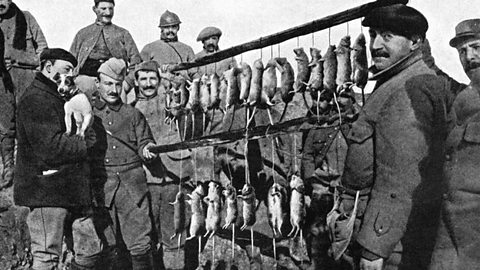
Not all animals were welcomed by soldiers. Rats fed on rotting food in the trenches and could have up to 900 babies every year.
Soldiers hated rats as they were smelly and spread diseases. They tried to get rid of them using clubs, bayonets and even guns.
Despite all this, rats were sometimes helpful. Many soldiers reported how rats sensed an oncoming attack and ran away, which warned them of enemy moves.
How did life change for animals and soldiers?
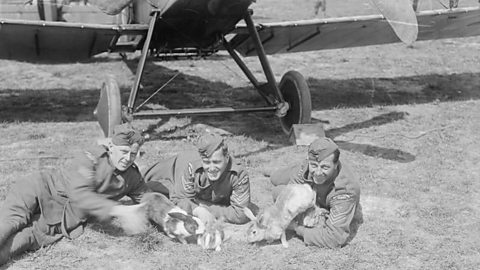
Animals were essential for both sides in World War One.
As well as working hard, they were important for morale. Soldiers were able to show their caring side by looking after animals.
How are animals remembered?

In 2004, a memorial was opened in London to remember animals that died in wars. This includes the animals that served and died in World War One. It was funded by a national appeal and bears two inscriptions:
The first explains the memorialâs dedication to all the animals that served and died alongside British and Allied forces in wars and campaigns throughout time.
The second is smaller but equally important to remember: âThey had no choice.â
Activities
Activity 1: Quiz â Animals during World War One
Activity 2: History Explorer game
Play this game to test your knowledge and learn even more facts about World War One.
History Explorer: Secrets through time
History Explorer: Secrets through time: KS2 History

Bitesize Primary games. gameBitesize Primary games
Play fun and educational primary games in science, maths, English, history, geography, art, computing and modern languages.

More on World War One
Find out more by working through a topic
- count13 of 43
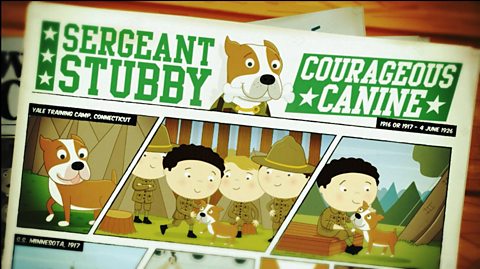
- count14 of 43

- count15 of 43

- count16 of 43
